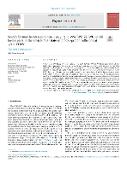Search for new heavy resonances decaying to WW, WZ, ZZ, WH, or ZH boson pairs in the all-jets final state in proton-proton collisions at √s=13 TeV

Autor
Tumasyan, A.
Adam, W.
Andrejkovic, J. W.
Bergauer, T.
Chatterjee, S.
Damanakis, K.
Dragicevic, M.
Del Valle, A. Escalante
Hussain, P. S.
Jeitler, M.
Datum vydání
2023Publikováno v
Physics Letters, Section B: Nuclear, Elementary Particle and High-Energy PhysicsRočník / Číslo vydání
844 (2023)ISBN / ISSN
ISSN: 0370-2693Informace o financování
MSM/LG/LG14004
Metadata
Zobrazit celý záznamKolekce
Tato publikace má vydavatelskou verzi s DOI 10.1016/j.physletb.2023.137813
Abstrakt
A search for new heavy resonances decaying to WW, WZ, ZZ, WH, or ZH boson pairs in the all-jets final state is presented. The analysis is based on proton-proton collision data recorded by the CMS detector in 2016-2018 at a centre-of-mass energy of 13 TeV at the CERN LHC, corresponding to an integrated luminosity of 138 fb-1. The search is sensitive to resonances with masses between 1.3 and 6 TeV, decaying to bosons that are highly Lorentz-boosted such that each of the bosons forms a single large-radius jet. Machine learning techniques are employed to identify such jets. No significant excess over the estimated standard model background is observed. A maximum local significance of 3.6 standard deviations, corresponding to a global significance of 2.3 standard deviations, is observed at masses of 2.1 and 2.9 TeV. In a heavy vector triplet model, spin-1 Z' and W' resonances with masses below 4.8 TeV are excluded at the 95% confidence level (CL). These limits are the most stringent to date. In a bulk graviton model, spin-2 gravitons and spin-0 radions with masses below 1.4 and 2.7 TeV, respectively, are excluded at 95% CL. Production of heavy resonances through vector boson fusion is constrained with upper cross section limits at 95% CL as low as 0.1 fb.& COPY; 2023 The Author(s). Published by Elsevier B.V. This is an open access article under the CC BY license (http://creativecommons .org /licenses /by /4 .0/). Funded by SCOAP3.
Klíčová slova
CMS, Diboson resonances, Substructure,
Trvalý odkaz
https://hdl.handle.net/20.500.14178/2360Licence
Licence pro užití plného textu výsledku: Creative Commons Uveďte původ 4.0 International






